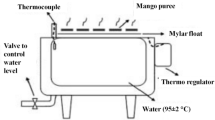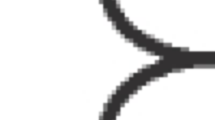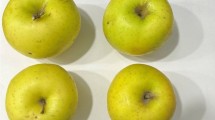Abstract
Being a seasonal fruit mango cannot be cherished over the year; dehydration may be a solution to preserve the deliquesce of mango as mango leather. The processing parameters like puree load (0.4–0.6 g/cm2), total soluble solid (20–30 °B), oven temperature (60–80 °C), and microwave power level (100–300 W) were optimised for a superior textural attribute (hardness) primitive drying method like sun drying, industrially practiced modern methods like hot air oven drying and microwave drying and cutting-edge drying technique like freeze-drying. Response surface methodology and artificial neural network technique were adapted to model these drying procedures by considering the central composite design. The mathematical operations guiding to describe the model were studied. Being an imperative parameter colour quantification is essential for food industries. Current research employs microwave drying to produce mango leather with colour quantification approach. The L, ‘a’ and ‘b’ values of the product have been measured by Hunter Lab colorimeter and by digital image analysis, to determine the chromatic view harmonious to human vision. The relative analysis of colour measurement through these two techniques has been studied.











Similar content being viewed by others
References
Sarkar, T., & Chakraborty, R. (2018). Formulation, physicochemical analysis, sustainable packaging-storage provision, environment friendly drying techniques and energy consumption characteristics of mango leather production: A review. Asian Journal of Water, Environment and Pollution, 15(3), 79–92.
Danalache, F., Mata, P., Martins-Moldao, M. M., & Alves, V. (2014). Novel mango bars using gellan gum as gelling agent: Rheological and microstructural studies. LWT—Food Science and Technology, 62, 576–583.
Alothman, M., Kaur, B., Fazilah, A., Bhat, R., & Karim, A. (2010). Ozone-induced changes of antioxidant capacity of fresh-cut tropical fruits. Innovative Food Science and Emerging Technologies, 11, 666–671.
Liu, R. H. (2003). Health benefits of fruit and vegetables are from additive and synergistic combinations of phytochemicals. The American Journal of Clinical Nutrition, 78, 517–520.
Robles-Sánchez, M., Astiazarán-García, H., Martín-Belloso, O., Rojas-Graü, M. A., Gorinstein, O., Alvarez-Parrilla, E., et al. (2009). Effect of minimal processing on bioactive compounds and antioxidant activity of fresh-cut “Kent” mango (Mangifera indica L.). Postharvest Biology and Technology, 51, 384–390.
Sarkar, T., Salauddin, M., Hazra, S. K., & Chakraborty, R. (2020). Effect of cutting edge drying technology on the physicochemical and bioactive components of mango (Langra variety) leather. Journal of Agriculture and Food Research, 2, 100074.
Huang, X., & Hsieh, F. H. (2006). Physical properties, sensory attributes, and consumer preference of pear fruit leather. Journal of Food Science, 70(3), 177–186.
Maskan, A., Kaya, S., & Maskan, M. (2002). Hot air and sun drying of grape leather (pestil). Journal of Food Engineering, 54(1), 81–88.
Diamante, L. M., Bai, X., & Busch, J. (2014). Fruit leathers: Method of preparation and effect of different conditions on qualities. International Journal of Food Science, 2014, 1–12.
Bourne, M. C. (2002). Food texture and viscosity: Concept and measurement. San Diego: Academic Press.
Sarkar, T., Salauddin, M., Hazra, S. K., & Chakraborty, R. (2020). Comparative study of predictability of response surface methodology (RSM) and artificial neural network-particle swarm optimization (ANN-PSO) for total colour difference of pineapple fortified rasgulla processing. International Journal of Intelligent Networks, 1, 17–31.
Behera, S. K., Meena, H., Chakraborty, S., & Meikap, B. C. (2018). Application of response surface methodology (RSM) for optimization of leaching parameters for ash reduction from low-grade coal. International Journal of Mining Science and Technology, 28(4), 621–629.
Jideani, V. A., Oloruntoba, R. H., & Jideani, I. A. (2010). Optimization of Fura production using response surface methodology. International Journal of Food Properties, 13(2), 272–281.
Akinoso, R., & Adeyanju, J. A. (2012). Optimization of edible oil extraction from Ofada rice Bran using response surface methodology. Food Bioprocess Technology, 5(4), 1372–1378.
Schoeninger, V., Coelho, S. R. M., Christ, D., & Sampaio, S. C. (2014). Processing parameter optimization for obtaining dry beans with reduced cooking time. LWT—Food Science and Technology, 56(1), 49–57.
Kumar, D., Prasad, S., & Murthy, G. S. (2014). Optimization of microwave-assisted hot air drying conditions of okra using response surface methodology. Journal of Food Science and Technology, 51(2), 221–232.
Sarkar, T., Salauddin, M., Hazra, S. K., & Chakraborty, R. (2020). Artificial neural network modelling approach of drying kinetics evolution for hot air oven, microwave, microwave convective and freeze dried pineapple. SN Applied Sciences, 2, 1621.
Balaban, M. (2008). Quantifying nonhomogeneous colors in agricultural materials part I: Method development. Journal of Food Science, 73, S431–S437.
Payman, M., Alireza, S., & Hossein, P. (2017). Computer vision-based apple grading for golden delicious apples based on surface features. Information Processing in Agriculture, 4(1), 33–40.
Cavallo, D. P., Cefola, M., Pace, B., Logrieco, A. F., & Attolico, G. (2019). Non-destructive and contactless quality evaluation of table grapes by a computer vision system. Computers and Electronics in Agriculture, 156, 558–564.
Zhang, M., Zhang, L., & Cheng, H. D. (2010). A neutrosophic approach to image segmentation based on watershed method. Signal Processing, 90(5), 1510–1517.
Balban, M. O. (2008). Quantifying nonhomogeneous colors in agricultural materials part I: Method development. Journal of Food Science, 73(9), 431–436.
Oliveira, A. C. M., Balban, M. O., Portier, K. M., & O’Keefe, S. F. (2006). Comparison of a colorimeter with a computer vision system in measuring color of Gulf of Mexico sturgeon fillets. Applied Engineering in Agriculture, 22(4), 538–587.
Russ, J. C. (2015). Image analysis of foods. Journal of Food Science, 80, 1974–1987.
Azeredo, H. (2006). Effect of drying and storage time on the physico-chemical properties of mango leathers. International Journal of Food Science and Technology, 41(6), 635–638.
Omolola, A., Olusegun, J., Afam, I. O. K., Patrick, F., & Jideani, V. A. (2015). Optimization of microwave drying conditions of two banana varieties using response surface methodology. Food Science and Technology, 35(3), 438–444.
Olusegun, D. S., & Modestus, O. (2018). Comparison of Response Surface Methodology (RSM) and Artificial Neural Network (ANN) in modelling of waste coconut oil ethyl esters production. Energy Sources, Part A: Recovery, Utilization, and Environmental Effects. https://doi.org/10.1080/15567036.2018.1539138.
Fadhil, R., Nurba, D., & Ikhwanto, K. (2017). The effect of different frying conditions on the color parameters of purple sweet potato (Ipomoea batatas Poiret) Slices. Carpathian, Journal of Food Science and Technology, 9(2), 35–42.
Magdic, D., & Dobricevic, N. (2007). Statistical evaluation of dynamic changes of ‘idared’ apples color during storage. Agriculturae Conspectus Scientificus, 72(4), 311–316.
Pascale, D. (2003). A review of RGB colour spaces from xyY to R’G’B’. Monteral: The Babel Color Company.
Varith, J., Dijkanarukkul, P., Achariyaviriya, A., & Achariyaviriya, S. (2007). Combined microwave-hot air drying of peeled longan. Journal of Food Engineering, 81(2), 459–468.
Meda, V., Mitra, P., & Lee, J. (2016). Optimization of microwave-vacuum drying processing parameters on the physical properties of dried Saskatoon berries. Open Agriculture, 1(1), 7–17.
Alex, M., & Monika, A. J. (2014). Texture changes during drying of apple slices. Drying Technology, 32(5), 567–577.
Swittra, B. N., Nantawan, T., & Pisit, D. (2011). Characterization of microwave vacuum-dried durian chips. Journal of Food Engineering, 104(1), 114–122.
Sarkar, T., Salauddin, M., Hazra, S. K., & Chakraborty, R. (2020). A novel data science application approach for classification of nutritional composition, instrumental colour, texture and sensory analysis of bael fruit (Aegle marmelos (L.) correa). International Journal of Intelligent Networks, 1, 59–66.
Sarkar, T., Nayak, P., & Chakraborty, R. (2020). Storage study of mango leather in sustainable packaging condition. Materials Today: Proceedings, 22(4), 2001–2007.
Acknowledgement
We acknowledge Dr. Subhendu Ghoshal for his support throughout the research work by providing necessary rare books and articles for a thorough literature survey. We also acknowledge the teaching and non teaching members of Malda polytechnic, Mr. Snehashis Guha (O.I.C. Malda Polytechnic) for their support throughout the work.
Author information
Authors and Affiliations
Corresponding author
Additional information
Publisher's Note
Springer Nature remains neutral with regard to jurisdictional claims in published maps and institutional affiliations.
Supplementary Information
Below is the link to the electronic supplementary material.
Rights and permissions
About this article
Cite this article
Sarkar, T., Salauddin, M., Choudhury, T. et al. Spatial optimisation of mango leather production and colour estimation through conventional and novel digital image analysis technique. Spat. Inf. Res. 29, 439–453 (2021). https://doi.org/10.1007/s41324-020-00377-z
Received:
Revised:
Accepted:
Published:
Issue Date:
DOI: https://doi.org/10.1007/s41324-020-00377-z




